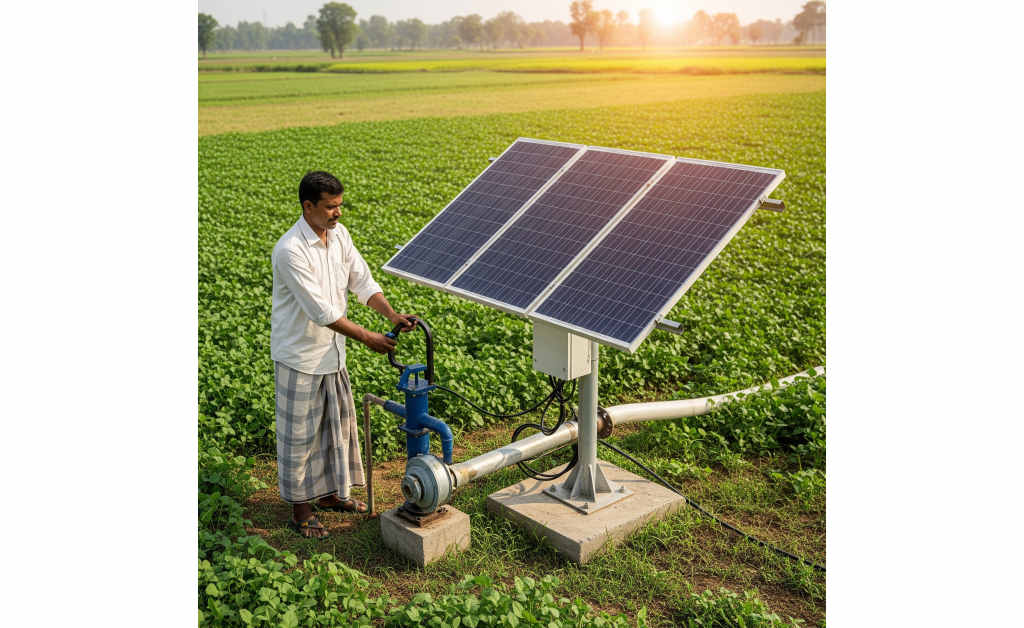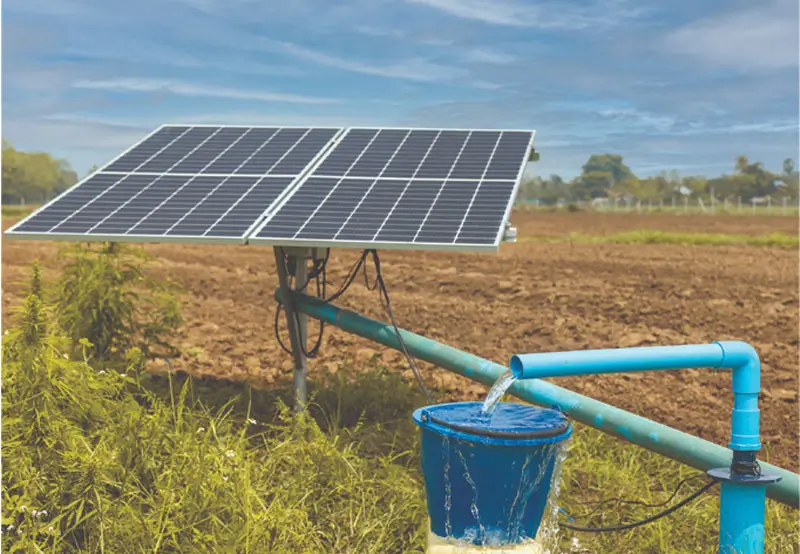Introduction
Agriculture forms the pillar of most economies globally, and irrigation is key to providing productive harvests. Yet, farmers constantly find themselves grappling with inconsistent electricity supply, volatile fuel prices, and water scarcity, making effective irrigation a perpetual problem. Solar water pumps for agriculture provide an eco-friendly solution by using solar power to deliver a reliable water supply, reducing reliance on fossil fuels and grid electricity.

Apart from their ecological advantages, solar irrigation systems are also economical in the long term. Farmers save money on electricity bills and fuel and also lower their carbon footprint. Although these are benefits, adoption is slowed down by high initial costs and low awareness. This is where incentives like the solar water pump subsidy program, tax relief, and grants come into picture. These incentives enable the farmers to shift to the solar powered water pump systems, enhancing their productivity and profitability.
In this piece, we are going to examine the increasing demand for solar pumps, incentive types, benefits of solar water pump systems, adoption hurdles, and real-world success stories highlighting how incentives spur solar pump uptake.
The Growing Need for Solar Pumps
Challenges Faced by Farmers
Farmers worldwide face multiple challenges in accessing reliable and affordable irrigation systems. The reliance on diesel-powered or grid-connected pumps often results in:
- High fuel and electricity costs: The price of fuel increases the cost of running diesel pumps, whereas tariffs for grid electricity are unpredictable.
- Irrational power supply: Most rural communities experience unreliable grid electricity, resulting in delayed irrigation and crop loss.
- Environmental concerns: Diesel pumps are sources of air pollution and greenhouse gas emissions, affecting sustainability.
- Depleting groundwater levels: Conventional irrigation practices usually result in over-extraction of groundwater, which brings long-term environmental damage.
Why Solar Pumps Are a Game Changer
Solar irrigation systems provide an attractive alternative, meeting most of these challenges. Their advantages are:
- Cost savings: Solar pumps save on fuel and decrease electricity reliance, resulting in substantial long-term savings.
- Sustainability: Solar-powered equipment reduces carbon footprints, promoting environmentally sustainable farming practice.
- Reliable irrigation: Solar pumps supply a reliable source of water, enhancing crop yields and climate change resilience.
Though the starting price is still a significant hindrance to broader adoption, incentives are needed.
Types of Incentives Available
Recognising the potential of solar pumps, governments and organisations around the world provide a range of incentives to enable farmers to use them.
1. Financial Subsidies and Grants
- Several governments offer solar water pump subsidy schemes that help cover most of the installation expenses.
- For instance, India’s PM-KUSUM program provides an up to 70% subsidy on solar pumps to make them affordable to marginal and small farmers.
2. Tax Benefits and Incentives
- Farmers are eligible to claim depreciation allowances on solar pumps, lowering taxable income.
- Most countries offer a reduction of import duty and tax relief on solar equipment, decreasing the price.
3. Low-Interest Loans and Credit Schemes
- Governments and financial institutions provide subsidized low-interest loans to induce investment in solar irrigation.
- The World Bank and NABARD (India) are institutions that offer credit-linked schemes to farmers.
4. Public-Private Partnerships (PPP) and NGO Support
- Government, private sector, and NGO collaborations assist in the deployment of solar pumps in the rural areas.
- Nonprofits provide technical training and assistance to ensure effective utilization and maintenance.
These rewards make solar powered water pump systems affordable, allowing farmers to transition to eco-friendly irrigation methods.
Benefits of Solar Pumps for Farmers
Adopting solar water pumps for agriculture provides numerous advantages:
1. Lower Energy Expenses
- Farmers benefit from saving on fuel and electricity charges, increasing profitability.
- With no constant energy cost, they achieve financial stability.
2. Increased Efficiency
- Guaranteed water availability contributes to increased crop output and quality produce.
- Prompt irrigation prevents the loss of crops, enhancing efficiency.
3. Sustainability and Eco-Friendly Advantage
- Solar pumps lower greenhouse gas emissions, supporting climate-friendly agriculture.
- They conserve water, enabling responsible use of irrigation.
4. Autonomy from Grid Electricity
- Farmers in isolated regions are able to use pumps off-grid, providing ongoing irrigation.
- Solar technology gives power security, insulating farmers from power outages and fuel supply shortages.
Through these advantages, solar irrigation systems open the door to more sustainable and robust agriculture.
Overcoming Barriers to Adoption
Despite the benefits, there are some drawbacks in deploying solar powered water pump technology on a large scale.
1. Hefty Start-Up Expenses
- Most farmers cannot meet the start-up cost.
- Solution: Easy access to loans and extra subsidies minimize financial burdens.
2. Lack of Awareness and Technical Expertise
- Farmers are not familiar with the solar technology and maintenance requirements.
- Solution: Government and NGO training schemes can assist farmers in adopting and maintaining solar pumps successfully.
3. Policy and Bureaucratic Barriers
- Long subsidy application procedures discourage farmers.
- Solution: Simplified forms and quicker incentive processing can enhance adoption rates.
By these barriers being broken, more farmers are able to transition towards solar irrigation systems.
Success Stories and Case Studies
1. India: PM-KUSUM Beneficiary – Ramesh Patel, Rajasthan
- Ramesh, a small farmer, struggled with high diesel costs.
- With a solar water pump subsidy, he installed a 5HP solar pump.
- Outcome: 30% cost savings, 20% increase in crop yield, and zero fuel dependency.
2. Kenya: Solar Irrigation for Smallholder Farmers
- The government and NGOs provided low-interest loans and solar pump training.
- Farmers reported 40% higher profits and improved irrigation reliability.
3. Bangladesh: Community-Based Solar Irrigation
- A cooperative model allowed farmers to share solar pumps.
- Outcome: Reduced costs per farmer and sustainable irrigation for multiple farms.
These case studies highlight how targeted incentives empower farmers, increasing adoption and agricultural productivity.
Conclusion
The adoption of solar water pumps for agriculture is a game-changer, offering financial savings, sustainability, and energy independence. Nevertheless, it is too expensive with low overall popularity due to a lack of awareness. Incentives like solar water pump subsidy programs, tax benefits, and financial support play a crucial role in overcoming these barriers.
Governments and organizations can speed the rate of transition to solar irrigation by empowering incentive schemes and easing access to the same. Encouraging farmers to embrace solar powered water pump technology will lead to higher agricultural productivity, economic stability, and a greener future.
It is high time to invest in solar irrigation- a move towards green and luxurious farming.
Frequently Asked Questions (FAQs)
The cost varies depending on capacity and location, ranging from $1,000 to $5,000. Government subsidies can significantly reduce costs.
Yes, regular cleaning of solar panels and checking pump components ensures efficiency and longevity.
Farmers can apply through government portals, agricultural departments, or authorized solar vendors.
Yes, solar pumps can function in low sunlight, but efficiency may be slightly reduced.
Yes, high-capacity solar pumps can support large farms with adequate water supply.












